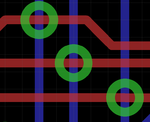sandbox
Junior Member level 1

- Joined
- Jan 9, 2012
- Messages
- 19
- Helped
- 0
- Reputation
- 0
- Reaction score
- 0
- Trophy points
- 1,281
- Activity points
- 1,434
Hi all,
I am designing a circuit board for a batch of 10000 boards, I have a few questions about good practices in PCB design, mostly pertaining to reliability and manufacturability. It would be really helpful if you could give me advice or direct me to any resources .
The first 3 are related to via's and PCB design :

These questions below are related to mass production :
Please help me out
Thanks in advance,
sandbox
I am designing a circuit board for a batch of 10000 boards, I have a few questions about good practices in PCB design, mostly pertaining to reliability and manufacturability. It would be really helpful if you could give me advice or direct me to any resources .
The first 3 are related to via's and PCB design :
- How reliable are via's , from a manufacturing standpoint do you end up with a lot of failed via's or are they generally reliable ?
- On the same note if you can route a short trace with a via and a longer trace without one, which one should be preferred ?
- i have a via as shown in the picture below, is that a good practice to have a junction at a via?

These questions below are related to mass production :
- How should I choose the material of the PCB ? considering its properties and eco friendliness ?
- How should I choose the thickness of the PCB?
- How much extra stock should I order considering some PCB's might fail, for example if i need to produce 100 boards how many more should I order as buffer to account for improperly produced ones?
- How do i optimize boards for pick and place assembly?
Please help me out
Thanks in advance,
sandbox
Last edited:





